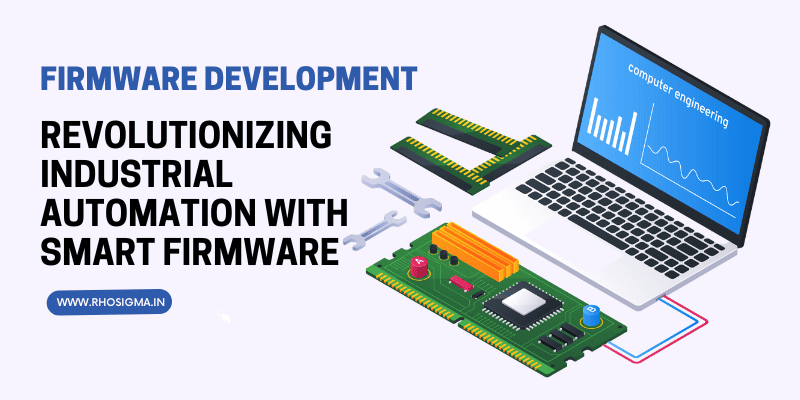Embedded Firmware vs. Software vs. Middleware: Key Differences Explained

Learn the key differences between embedded firmware, software, and middleware. Understand their roles, features, and applications in modern technology systems.
Imagine your smartwatch tracking your heartbeat or your car’s advanced braking system activating precisely when needed. These innovations rely on intricate systems composed of firmware, software, and middleware. Despite their critical roles, these terms often confuse even tech enthusiasts. This article clarifies their differences, roles, and how they interconnect in technological systems.
Looking to develop cutting-edge firmware or embedded solutions? Explore Rhosigma’s Embedded Firmware Development Services.
What Is Firmware? The Core of Hardware Control
Firmware refers to low-level instructions stored in permanent or semi-permanent memory, such as ROM or flash memory. It controls the hardware's operations directly, ensuring the device starts and functions as intended.
Key Features of Firmware
- Persistent Storage: Firmware remains intact even when the device is powered off.
- Essential Operations: It initiates the hardware, sets up components, and facilitates basic communication between parts.
- Security Roles: It includes measures like authentication to safeguard the device from unauthorized access.
Examples of Firmware
- BIOS in computers initializes hardware during startup.
- Device-specific Firmware powers appliances like digital cameras, printers, or smart refrigerators.
What Is Embedded Software? Broader in Scope
Embedded software builds upon firmware, encompassing all layers of code required to operate a device effectively. Unlike firmware, it may include additional functionalities beyond direct hardware control.
Characteristics of Embedded Software
- Hardware-Specific: Embedded software is developed for particular hardware configurations.
- Efficient Design: It operates within strict resource constraints, ensuring minimal usage of processing power and memory.
- Real-Time Operation: Some embedded software handles tasks requiring immediate responsiveness, such as medical equipment or automotive safety features.
Types of Embedded Software
- Operating Systems: Provide system management and interface tools (e.g., FreeRTOS).
- Applications: Manage user-facing functions, such as an infotainment system in vehicles.
→ → Mastering Embedded Firmware Development: Required Skills and Expertise
What Is Middleware? Bridging the Gaps
Middleware is a mediator, enabling communication between the hardware, firmware, and application layers. It simplifies development by handling repetitive or complex tasks like data exchange and device management.
Middleware Features
- Abstract Communication: Provides APIs for seamless data flow across components.
- Enhances Development: Developers can focus on application logic without worrying about low-level processes.
Examples of Middleware
- Protocol-based systems like MQTT for IoT communication.
- Middleware frameworks managing network communication in enterprise environments.
Comparing Firmware, Software, and Middleware
| Aspect | Firmware | Embedded Software | Middleware |
|---|---|---|---|
| Scope | Hardware-specific | Broader functionality | Intermediary layer |
| Purpose | Controls hardware directly | Operates the entire device | Manages communication |
| Storage | Non-volatile memory | Volatile or non-volatile | Dynamic, runtime memory |
Real-Life Applications
Consumer Electronics
Smartphones utilize firmware to manage hardware boot processes, embedded software for app functionality, and middleware for cloud connectivity.
Automotive Systems
Vehicles integrate firmware for engine control, embedded software for navigation systems, and middleware for managing sensor data.
Healthcare
Medical devices like pacemakers rely on firmware for operation, embedded software for advanced diagnostics, and middleware for data transmission.
Discover how Rhosgma serves industries like healthcare, automotive, and IoT with end-to-end solutions. Explore our services.
Challenges and Emerging Trends
Challenges
- Resource Constraints: Managing limited memory and processing power remains critical.
- Security Threats: Devices require robust safeguards to prevent data breaches.
- Real-Time Responsiveness: Critical systems must operate without delay, adding complexity to the design.
Emerging Trends
- IoT Expansion: Middleware plays a pivotal role in connecting diverse devices.
- AI Integration: AI-powered features in embedded systems are transforming industries.
Conclusion
Firmware, embedded software, and middleware are distinct yet interconnected components driving modern devices. By understanding their roles and differences, developers can create efficient and secure systems that power everything from smart homes to industrial machinery.
Start your next project with Rhosigma! Contact us today to discuss your requirements for firmware, software, or middleware development.
Additional Resources
For those looking to delve deeper into embedded firmware development, consider exploring these resources:
1. Embedded Firmware Development Skills and Expertise
2. Firmware Development Process: Challenges and Best Practices










